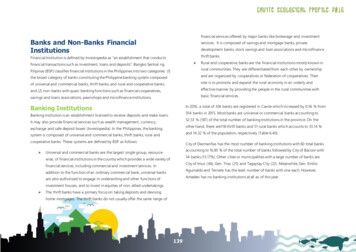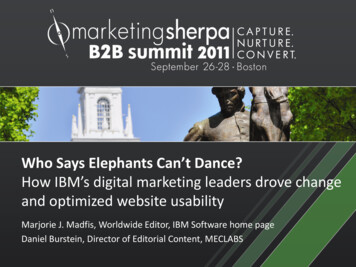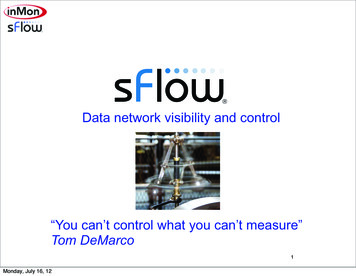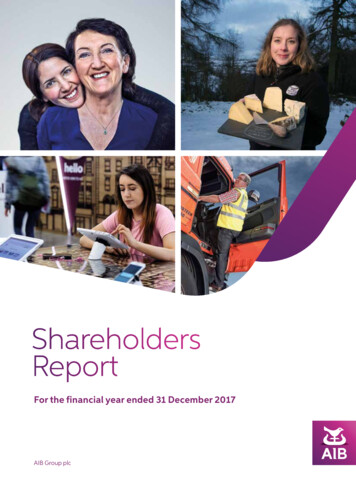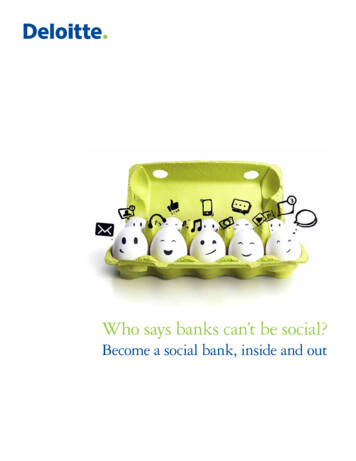
Transcription
Who says banks can’t be social?Become a social bank, inside and out
HeadlineContentBanking meets “social” .2Becoming a social bank .3Social media framework for banks .4Social strategic context .6Integrated social business model .7Social banking puzzle .9Social banking in action .16Go social now! .19Discover the Deloitte difference .21iiWho says banks can’t be social? Become a social bank, inside and out
The social media revolution has already happened,transforming not only your customers’ daily behaviourbut their expectations of you as their financial partner. Intoday’s social world, customers demand to be heard, understoodand valued. If your bank wants to drive stronger, sustainable,profitable and mutually beneficial relationships in this new socialreality, you must learn more about your customers – and listenwhen they speak.Leading banks around the world are already responding tothis trend by evolving into social banks, ones that embracetransparency and two-way interaction through social media tomeet and exceed customer expectations. A social bank pursuesmission-appropriate engagement with its customers, aligning itssocial efforts with its core business strategy and brand image. Itbuilds the organizational capabilities needed to process customerinsights and adopts change management strategies that let itreact to this input in meaningful ways.Canada is considered one of the world’s most socially connectedcountries, with over 50% of the population using social mediatools. This presents a tremendous opportunity for Canadian banksto learn from leading organizations and industries as they pushthe envelope by transforming into social banks.Who says banks can’t be social? Become a social bank, inside and out1
Banking meets “social”Since the launch of Facebook in 2004, banks have increasingly adopted social media technologies. In addition tolaunching Facebook profiles, most major banks have also adopted Twitter as a new marketing and customer serviceavenue. While these steps are necessary, banks are beginning to understand that those services are simply the tip of theiceberg. “Social” in fact, has a lot more to offer.The “anti-social” bankThe “social dabbler” bankAs opposed to consumer retail businesses, banks aretraditionally perceived to be non-social. And for goodreason – in today’s heavily-regulated environment, banksare understandably sensitive to the reputational riskinherent in social media. This makes it difficult to thinkof engaging in two-way dialogues with customersor expanding the scope of customer service throughsocial channels.This is not to say that banks are naïve when it comesto social media. The majority of banks have decided todabble in the social landscape, deploying presences onFacebook and Twitter. Unfortunately, their siloed approachhas frequently resulted in a lack of engagement, minimalfan growth and social presences that resemble “ghost”communities.Often, banks recognize the benefits of enhancingtheir social capabilities, but are unsure where to start.Discussions on how to build a more comprehensivestrategy are often cut short by statements like: “Our customers don’t expect us to be social.” “We already focus on connecting with our customersthrough the branch.” “Differentiating through social media isn’t possiblefor banks.” “We are too bound by regulation to explore this space.”To truly realize the power of going social, banks mustmove beyond one-off social deployments. Instead, theymust adopt a business culture that taps into the expertiseof employees and customers, solicits and takes actionon customer feedback, and builds a brand around socialinterests. Social banks foster a culture that embracesthe voice of the customer. By developing and sustainingrelationships that extend beyond single transactions,they create opportunities for both the business andtheir customers.For these and other reasons, banks that want to staycompetitive and differentiate themselves need to beginbuilding a social banking business. True social banks areinevitable. Companies that realize this potential first willhave a huge advantage.Sound familiar? Your bank should consider the followingtrends observed in your customers:Shifting away from the branch: 45% ofbank customers visit their local branch fewer thanfive times per year.They are getting on it: 38% of people 65 orolder use social media and represent the fastestgrowing demographic.Finding new avenues to connect: 31% morefinancial customers visit leading social networkingsites each year.They see your competitors responding: Ofthe 50 largest banks in the world, over 90% areon Facebook and 88% are on Twitter.They are already on it: 92% of the 18 to 29 yearold demographic uses social media.2Who says banks can’t be social? Become a social bank, inside and out
Becoming a social bankWhat is a social business?The advent of social media has altered the traditional relationship between business and customer, much as it haschanged how individuals interact with one another. With social media, customers have acquired a public voice thatcan influence friends, family, co-workers and distant connections – almost anywhere in the world, and all with a singlemessage. Banks that embrace this new dynamic – that internalize and change in response to direct customer engagementand shift away from thinking in terms of customer transactions to thinking in terms of customer relationships – becomesocial banks.What social businesses doWhy social businesses do itEmbrace the voice of the customer:A social business understands that customerword-of-mouth is worth more than paid adsand marketing collateral.To create value for the business and customers:A social business understands that successful engagementcreates value for both parties. When shared value iscreated, both the business and the customer win.What are you more likely to trust – a TV commercialor customer reviews found on Yelp?Move from transactions to relationships:A social business understands that proactively respondingto stories, experiences, ideas and complaints in real timedeepens customer relationships.Have you ever had to repeat your request multiple times,or across multiple channels (in store, call channel, etc.)while trying to get an issue resolved?Internalize feedback:A social business recognizes that customer conversationsand insights affect the entire organization – from productinnovation and recruiting to sales lead generation andbeyond.Have you ever had a great idea for improving a productor service but didn’t know how to get it to someonewho matters?Do you take advantage of online reviews?Customers frequently consult online reviews beforemaking purchasing decisions. Providing a forum forcustomers to create and read reviews on your site keepscustomers informed – and can increase your sales.To meet customer expectations:A social business recognizes that while customers maychoose to interact across a variety of channels, they expecta consistent quality of service. This means providing rapidresponse and resolution to customer inquiries received onsocial channels.Don’t want to lose a sales lead?Customers may visit social channels at any stage in thebuying process. Deploying real-time mortgage specialiston social channels can capture interest from onlinesavvy first-time home buyers.To hone their competitive edge:Social businesses are tuned in to the opinions of theircustomers and understand what their customers need.These organizations integrate social activities into routineoccurrences with the customer.Do your customers work for you?Targeted online communities enable the“crowdsourcing” of insights from customers. BarclaycardUS introduced Ring, an online community wherecustomers are invited to shape the credit cards offeredby the bank. Increased retention and reduced customercomplaints resulted in bottom line benefits to the bankand a compelling offering for customers.Who says banks can’t be social? Become a social bank, inside and out3
Social mediaframework for banksThe Social Media Framework for Banks provides a high-level guide to achieving the transition to social bank. Regardlessof where your bank is on its social journey, the framework can be used to evaluate, plan, strategize and act upon yourcustomer-focused social efforts.The framework presents key considerations in three layers:Social Strategic ContextA social bank requires a well-defined social visiontailored to support its business drivers, brandimage, and corporate strategy. Your entire organizationneeds to be aligned and aimed towards a company-widegoal appropriate to your business, customers, and valueproposition.Integrated social business modelSocial banks adapt their operations to delivervalue through social channels and make use ofsocial insights. From the front line to the back office,departments must be given the training and flexibility toprovide service on social channels. Mechanisms must beput in place to enable the harvesting of social insightsso that stakeholder groups throughout the business canmeet their individual goals and deliver on the overarchingbusiness strategy.Social puzzleWhat is right for others may not be right foryou. Banks today pursue many different socialinitiatives with varying degrees of success. No matter whatyour bank’s strategy and vision, the social puzzle consistsof five pieces that you need to consider: Social banking interactions: Discover how to engagewith your customers to create shared social value. Social ecosystem: Understand the mix of socialchannels required to support your goals. Socially extended bank channels: Augment traditionalbanking channels help customers connect wherever andwhenever they want. Experimentation: Pilot your social concepts to refineyour understanding of your customer’s expectationsand evolve your internal capabilities. Risk & control (legal & compliance): Apply consistentcontrols across channels and departments engaged withor leveraging social media.The Social Media Framework for Banks provides a highlevel guide to achieving the transition to social bank.Regardless of where your bank is on its social journey, theframework can be used to evaluate, plan, strategize and actupon your customer-focused social efforts.4Who says banks can’t be social? Become a social bank, inside and out
The social media framework as it applies to banksBanking socialstrategic contextIntegratedSocial businessmodelStrategy& visionHRProductSocial lecosystemSocial insightsSocial insightsRisk &controlInternal evolutionInternal evolutionSocially extendedbank socialvalueSales onappropriateengagementWho says banks can’t be social? Become a social bank, inside and out5
Social strategic contextDefining your strategy and visionDefining your social strategy and vision can be challengingconsidering the breadth of possibilities presented by socialmedia. Where one bank may focus on improving customerexperience by providing financial advice forums, anothermay prefer to enhance product innovation by introducingcustomer reviews. Banks should begin with one keyquestion: “How can social media help us achieve ourbusiness objectives?”It’s easy to fall into a trap of deploying overly broad socialinitiatives that attempt to address every possible needand usage scenario. To avoid this, stay focused on yourstrategy and vision while incrementally building socialpilots, expanding your social ecosystem and augmentingtraditional bank channels.Common strategic themes supported by social Enhance online brand presence and recognition Improve customer experience and service Segment customer base and gain customer insights Drive product innovation and ideation Increase revenue through marketing Reduce operating costs Support recruitingMission-appropriate engagementand shared social valueSeveral elements separate a successful social bank fromone that simply deploys a Facebook profile page:Mission-appropriate engagement: The degree to whichthe bank connects with customers in a manner consistentwith the brand’s image and value proposition. Missionappropriate engagement is achieved when the methodsused to engage with customers make sense within thecontext of your strategy, business model, and brand.Shared social value: The degree to which the bank’s socialinitiatives create value for both your customers and the bankitself. This means customers need to see a reason to useyour bank’s social mechanisms (e.g., to learn something,complete a transaction, or achieve a sense of prestige),while your bank needs to be able to take their input orcreate interactions that help achieve your strategic goal.Brand presence and reputationWhen social media first became popular, many businessesassumed it would simply act as an extension of their existingbrand channels. While this perspective proved too narrow,a well-executed social presence can still contribute to theperception of your brand. Embracing mission-appropriateengagement, creating shared value, and executing on adefined vision while leveraging key brand concepts and
The Social Media Framework for Banks provides a high-level guide to achieving the transition to social bank. Regardless of where your bank is on its social journey, the framework can be used to evaluate, plan, strategize and act upon your customer-focused social efforts. The framework presents key considerations in three layers: Social media
